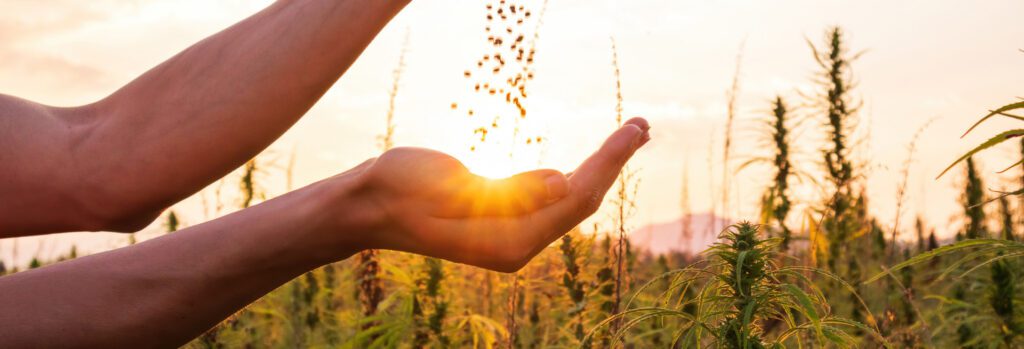5 Quebec Business Grants You Can Apply to Right Now
From innovative startups to established enterprises, securing funding can be a game-changer for y...

Hemp waste and cannabis waste hold a treasure trove of untapped innovation opportunities. In May 2019, the Canadian government published a report scoping the commercial cannabis production in the province of British Columbia. In this report, it was estimated that 6,000 tons of cannabis-related waste would be produced by 2020. To put this into perspective, this is equivalent to a cargo full of waste per year, for this province alone.
While hemp and cannabis share a genetic lineage, as two species of Cannabaceae family, their differences in terms of THC (the psychoactive compound associated with cannabis use) and CBD content, legal status, and intended uses, result in distinct classifications and applications.
Hemp plants are specifically cultivated to have very low THC levels, typically below 0.3%. The crops tend to be tall and slim, with leaves concentrated toward the top of the plant. The focus is often on maximizing fiber and seed production.
Hemp, a versatile and sustainable crop, has gained considerable attention for its myriad applications, from textiles to cosmetic products. Yet, beyond its primary uses, hemp holds another treasure trove of possibilities: its waste. The byproducts and residues generated during hemp production can be transformed into valuable resources, offering innovative solutions for numerous industries.
Cannabis plants can have varying levels of THC, with some strains containing significantly higher levels, often above 20% THC content. The plants have a wider variety of appearances, and the main focus is typically resin and flower production. Solid waste from cannabis production is mainly generated from agricultural inputs. Some of the discarded substances are considered hazardous waste due to their high THC concentration, which implies that they are subject to greater handling and repurposing restrictions.
Both hemp and cannabis alike differ from other crops grown in Canada, based on their ability to produce several rotations per year. This means that the volume of waste generated may be higher than the average cultivated crop on an annual basis. Hence, their remarkable potential as an eco-friendly resource becomes evident, as their frequent harvests offer a consistent and sustainable source of raw materials for a wide array of industries.

Hemp, known for its diverse and valuable properties, retains a wealth of beneficial characteristics in its waste, rendering it an attractive and versatile input material for a wide range of applications.
For instance, it can be converted into biofuels through processes like pyrolysis and fermentation. These biofuels, such as bioethanol and biodiesel, offer an alternative to fossil fuels, reducing carbon emissions and contributing to sustainable energy production. The biomass can also be utilized to create bioplastics, which are eco-friendly alternatives to conventional plastics derived from petrochemicals. They are biodegradable and have various applications, including packaging materials, disposable utensils, and agricultural films.
Additionally, hemp hurd can be repurposed to produce hempcrete, a lightweight construction material offering excellent thermal and acoustic insulation properties while sequestering carbon dioxide, creating a sustainable alternative to traditional concrete. These properties are also found in other parts of the plant’s waste, which makes it a great resource for producing any kind of insulant material (for clothing and home textiles, for example).
Hemp is also known for its ability to absorb pollutants from the soil through a process called phytoremediation. After cleaning contaminated soil, the biomass can still be used for various purposes, including those mentioned previously.
While the reuse of hemp waste is not a recent finding, the growing interest in sustainability, environmental conservation, and the development of new technologies on a global scale has led to a renewed focus on maximizing the use of hemp waste in various industries. Additionally, changing legal landscapes related to hemp cultivation and the increasing demand for eco-friendly products have contributed to the exploration of innovative applications for hemp waste in recent years. This surge in interest has unveiled a plethora of untapped innovation opportunities, fostering creativity and experimentation across diverse sectors eager to harness the potential of this versatile resource.
Cannabis waste offers similar opportunities, however it is often constrained by stricter regulations and security considerations due to the presence of the psychoactive compound THC. The main concern revolves around ensuring that THC does not enter the environment upon solid waste disposal. The range of THC content in discarded cannabis plant parts (dry weight) varies greatly, from <0.03% in the roots to up to 24% in flowers. The separation of plant parts by THC content is a logistically complex challenge that has yet to be made compliant with the overarching goals of waste management in the cannabis industry (namely secure disposal and compliance with local regulations).
Conclusion
Hemp and cannabis waste are far more than a discarded byproduct; it’s a valuable resource with the potential to revolutionize industries and promote sustainability. As we explore innovative ways to reduce waste and environmental impact, the recycling opportunities of cannabacae byproduct rise as a key contributor to a more sustainable and circular economy.
Companies that are innovating in this sector are likely to be eligible for several funding programs including government grants, and SR&ED.
Want to learn about funding opportunities for your project? Schedule a free consultation with one of our experts today!
Source:
Explore our latest insights
More arrow_forward
From innovative startups to established enterprises, securing funding can be a game-changer for y...

Have you heard about the SR&ED updates proposed in the Federal budget 2024? Learn how these u...

In a groundbreaking development, researchers at the University of California Berkeley have design...

A new tax credit, the clean hydrogen tax credit, may be on the horizon for businesses that invest...